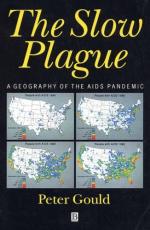|
This section contains 2,234 words (approx. 8 pages at 300 words per page) |

|
The human immunodeficiency virus/acquired immunodeficiency syndrome (HIV/AIDS) has reached pandemic proportions and has presented a multiple-dimension challenge for science, technology, and ethics. In 2004 approximately 39.4 million people worldwide were infected with HIV/AIDS, among whom about 3.1 million died in that year, including about 510,000 children under age fifteen. The Joint United Nations Programme on HIV/AIDS/World Health Organization (UNAIDS/WHO) estimates that in that year 4.9 million new infections occurred. Impacts have been more severe in southern Africa, where about one-third of the deaths occurred in 2004 and where life expectancies have dropped by more than 20 years in some countries. HIV/AIDS increasingly affects women and children; nearly half of those infected worldwide are female, with even higher infection rates for women in Africa. Infected pregnant and nursing women can pass the disease to their babies.
Between 2001 and 2004 global funding for HIV/AIDS relief tripled to $6.1 billion...
|
This section contains 2,234 words (approx. 8 pages at 300 words per page) |

|


